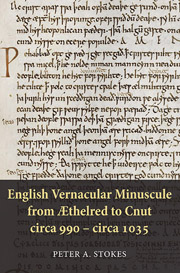Book contents
- Frontmatter
- Contents
- Lists of Tables
- Lists of Figures
- Lists of Plates
- Acknowledgements
- List of Abbreviations
- Introduction
- 1 Background
- 2 Attributions of Origin
- 3 Scribal Change in Bookhands and Charters: The ‘Tall and Narrow’ Hands
- 4 Scribal Continuity in Bookhands and Charters: The ‘Square-Influenced’ Hands
- 5 Glosses and Scribbles
- Conclusion: Change and Continuity in Early English Vernacular Minuscule
- Appendix. List of Scribal Hands
- Glossary
- Bibliography
- Index of Manuscripts and Charters
- General Index
- Plate section
Conclusion: Change and Continuity in Early English Vernacular Minuscule
Published online by Cambridge University Press: 05 April 2014
- Frontmatter
- Contents
- Lists of Tables
- Lists of Figures
- Lists of Plates
- Acknowledgements
- List of Abbreviations
- Introduction
- 1 Background
- 2 Attributions of Origin
- 3 Scribal Change in Bookhands and Charters: The ‘Tall and Narrow’ Hands
- 4 Scribal Continuity in Bookhands and Charters: The ‘Square-Influenced’ Hands
- 5 Glosses and Scribbles
- Conclusion: Change and Continuity in Early English Vernacular Minuscule
- Appendix. List of Scribal Hands
- Glossary
- Bibliography
- Index of Manuscripts and Charters
- General Index
- Plate section
Summary
In the previous chapters of this book, almost five hundred scribal hands which I have dated approximately 990 × 1035 have been surveyed, analysed and compared. These chapters have contained careful analyses of vast amounts of detail, detail which has both allowed the hands to be classified into broad styles and permitted these styles to be associated, to a greater or lesser extent, with Anglo-Saxon scriptoria. Necessary as this has been, we must now take a step back and place the results into their larger palaeographical and historical context. To begin, then, it is worthwhile briefly to summarise the main styles of Vernacular minuscule as presented in this book and to consider these styles in terms of scribal change and continuity. Once this has been done, the mechanisms for both change and continuity can be examined in order to draw larger conclusions about scribal practices and historical circumstances in early eleventh-century England.
A Brief History of the Script
To begin this broad analysis of English Vernacular minuscule it is worth asking what chronological trends can be recognised for the whole of England. Ker noted that late Anglo-Saxon script moved from Square minuscule through a period of comparative disorder during which features of tenth-century script were slowly removed from the corpus of available letter-forms. This process resulted in a rotund style influenced very heavily by Caroline script, which seems to have been developed by the mid-eleventh century and practised throughout England. His assessment is certainly accurate, but now we can obtain greater precision than was possible in his time.
- Type
- Chapter
- Information
- Publisher: Boydell & BrewerPrint publication year: 2014



